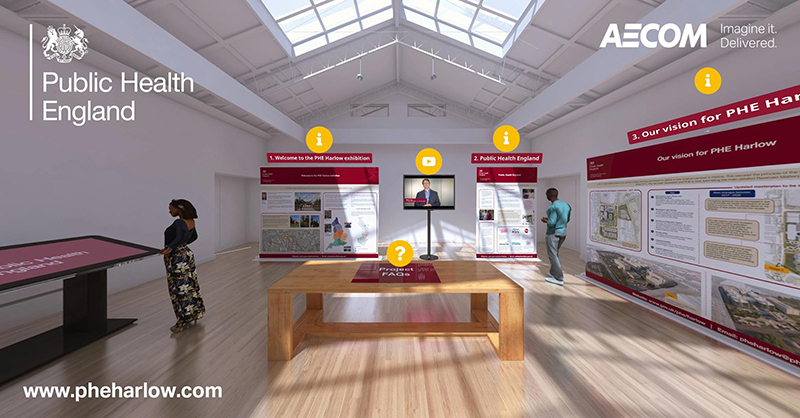Digital transformation isn’t just ‘nice to have’ – it’s critical
At AECOM, we recognize that it’s essential to embrace new technologies to solve increasingly complex challenges for our clients. We’ve had a digital transformation program in place for several years and are pleased to be at the forefront of addressing an industry-wide need to improve productivity and efficiency.
The coronavirus crisis has shown just how essential innovation is. In response to the pandemic, we moved the majority of our 14,000 staff across Europe, the Middle East and Africa (EMEA) to remote working — in some cases practically overnight. That was possible because we’d already invested in the technology and infrastructure to allow our teams to work remotely and with agility. However, we never anticipated working from home at this scale. When the pandemic first began, several of our leaders had reservations as to how this would work for a prolonged period of time for so many people. We’ve been able to not only sustain in this new working arrangement for more than three months, but also to thrive.
The coronavirus has forced the pace of change — and we need to keep that up. The lockdowns have prompted us to migrate more projects to secure cloud-based platforms and massively accelerate our BIM360 virtual training program to reach more than 400 people in each session. In doing so, we’ve been able to complete six months of in-person training in just a few weeks!
We’ve also seen how digital tools have enabled the super-rapid completion of projects during this crisis. We delivered the NHS Louisa Jordan coronavirus field hospital in Glasgow, Scotland, with zero defects in just three weeks, thanks to embedding dynamic digital tools to record and monitor defects in real time.
Overall outcomes of AECOM’s digital transformation
The adoption of digital tools and processes has helped us work faster, smarter and better, and our clients are benefiting from improvements in quality, cost and schedule. We’re continually innovating and developing our own tools and processes such as the Reality Capture tool which visually captures on-site construction progress in minutes, and provides open access to all stakeholders to share information easily and efficiently.
I should also highlight a couple of other brilliant solutions such as the Playbook information management platform we’ve developed for LinkedIn and others, and the virtual public consultation tool developed by VR Lead Andy Thomas that is now being used by a number of councils in the UK, Public Health England and the U.S. Army Corps of Engineers. We have talented, insightful people who are bringing digital and innovation to the forefront of how we deliver spot-on solutions for our clients’ challenges.

Next steps
A full transition to making digital “business as usual” is the next step, and to do this we need to focus on skills. We want everyone at AECOM to be able to design for and in the future. The 2D to 3D upskilling program we’re launching this year for more than1,000 people across EMEA is ambitious, but essential, and I’m excited to see where it will take us.
Upskilling more of our people is key to our success and we are embedding a strong digital and innovation culture through internal competitions such as our Mindblazer and Global Challenge programs. Ian Small, our EMEA Innovation Champion, has been sourcing fantastic solutions through these programs, which encourage innovation and ideas from any employee in any part of the company. Our EMEA Digital Project Delivery team has then been driving this innovation into projects, in partnership with our teams and clients. We’re seeing great outcomes as a result, such as the UK’s first Digital ES for the A303 project for Highways England.
The post-coronavirus recovery
Digital adoption is really a means to transforming outcomes for communities, and our off-site volumetric solution, INNO, that has been developed with Rogers Stirk Harbour + Partners, is helping to accelerate the delivery of much needed homes. Working virtually in BIM360, producing Design for Manufacture and Assemblydetailing, we’re able to deliver higher quality, low-carbon homes, in half the time. I’m hoping that success will breed further success and increase digital adoption in our industry.
Once clients start experiencing the benefits — the savings, collaboration, efficiencies, better environmental, social and governance (ESG) outcomes, and more effective operation and maintenance — we’ll start to tip the scales toward digital and innovation as commonplace in the construction industry.
We’re also supporting our clients in their digital transformation journeys as well as our own — delivering a more resilient way of working in the post-coronavirus recovery. The recent crisis has accelerated the transition and we need to build on that momentum. We are proud of the market-leading work we are delivering with the development and use of digital libraries and common data environments, both of which were invaluable to keep design and collaboration going in a virtual environment. As we come out of this crisis we can’t go back to business as usual — we want to accelerate the industry’s digital transformation and support communities in their recovery.






